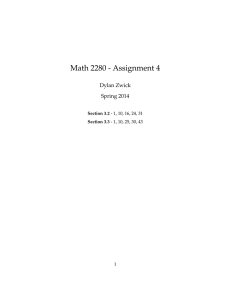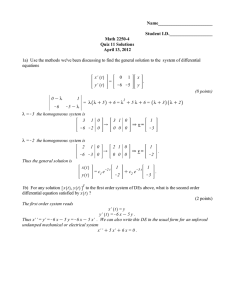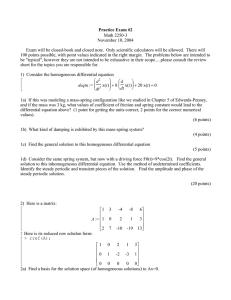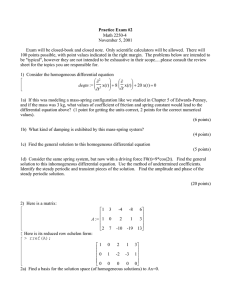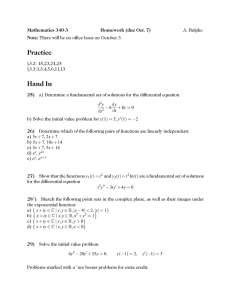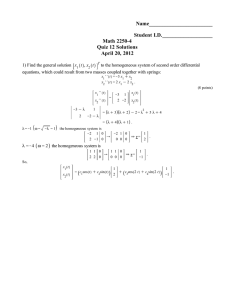Linear Differential Equations What do we know about linear differential equations? Slide 1
advertisement
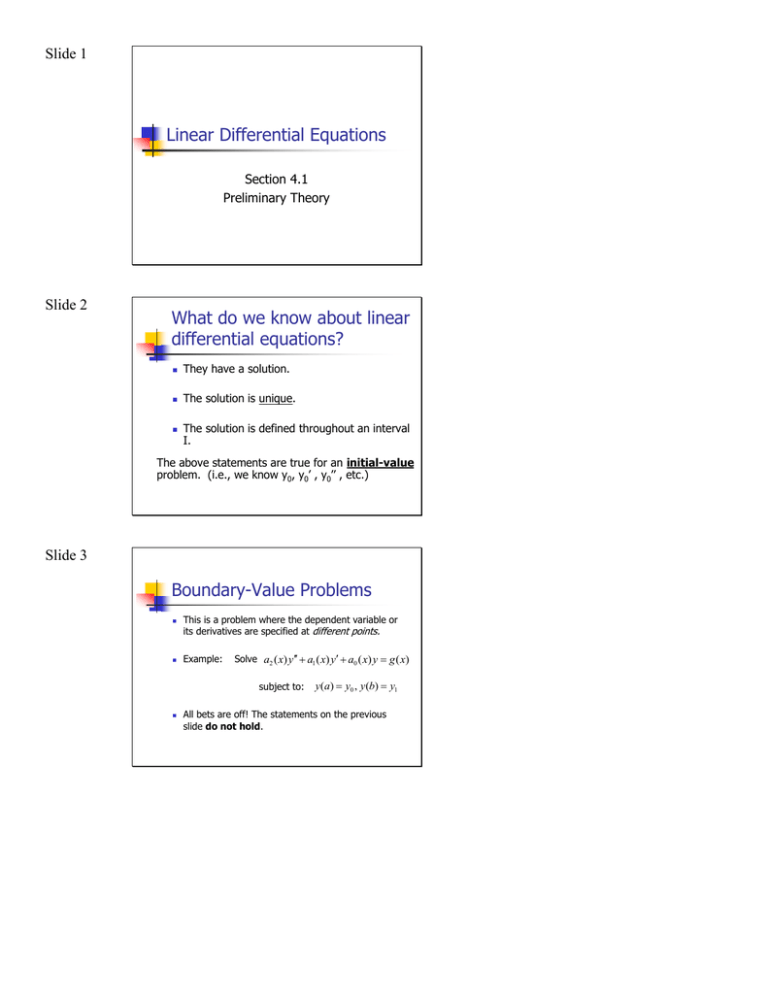
Slide 1 Linear Differential Equations Section 4.1 Preliminary Theory Slide 2 What do we know about linear differential equations? They have a solution. The solution is unique. The solution is defined throughout an interval I. The above statements are true for an initial-value problem. (i.e., we know y0, y0’ , y0’’ , etc.) Slide 3 Boundary-Value Problems This is a problem where the dependent variable or its derivatives are specified at different points. Example: Solve a2 ( x) y a1 ( x) y a0 ( x) y g ( x) subject to: y(a) y0 , y(b) y1 All bets are off! The statements on the previous slide do not hold. Slide 4 Examples #2 #13 Slide 5 Two Types of Linear Equations Homogeneous an ( x) y ( n ) an 1 ( x) y ( n 1) a2 ( x) y a1 ( x) y a0 ( x) y 0 an ( x ) y Nonhomogeneous (n) an 1 ( x) y ( n 1) a2 ( x) y a1 ( x) y a0 ( x) y g ( x) Later you will see that in order to solve a nonhomogeneous differential equation, we must first solve the associated homogeneous system. Slide 6 Assumptions We will always assume the following unless stated otherwise: The coefficients ai(x) are continuous. g(x) is continuous. a n(x) ≠ 0 for every x in the interval. Slide 7 nth-Order Differential Operator L an ( x) D n an 1 D n 1 a1 ( x) D a0 ( x) L is a linear operator. i.e., L f ( x) g ( x) L f ( x) Lg ( x) Slide 8 Example Express in terms of the D notation. y 7 y 10 y 24e x Slide 9 Superposition Principle Any linear combination of solutions of a homogeneous nth-order differential equation is also a solution of the equation. i.e., if y1, y2, …, yn are solutions then y = c1y1 + c2y2 + … + cnyn is also a solution where ci’s are arbitrary constants. Slide 10 Corollaries A constant multiple of a solution is a solution. A homogeneous differential equation always possesses the trivial solution y = 0. Slide 11 Linear Independence A set of functions f1, f2, …, fn is linearly dependent on an interval I if there exist constants c1, c2, …, cn not all zero such that c1f1 + c2f2 + … +cnfn = 0 for every x in I. If a set of functions is not linearly dependent, it is linearly independent. Slide 12 Examples Are f(t) = sin 2t and g(t) = (cos t)(sin t) linearly independent? Are f(t) = e3t and g(t) = t+1 linearly independent? A set of functions will be linearly dependent if at least one of the functions can be written as a linear combination of the others. Slide 13 Wronskian and Linear Independence It turns out that a set of functions is linearly independent on I if and only if the Wronskian is not equal to 0 for every x in the interval Slide 14 Fundamental Set of Solutions A set of n linearly independent solutions of a homogeneous linear nth-order differential equation is called a fundamental set of solutions. Theorem 4.4 states that a fundamental set of solutions will always exist for a homogeneous linear differential equation. Slide 15 Example #16 Slide 16 Theorem 4.5 Let y1, …., yn be a fundamental set of solutions of a homogeneous nth-order linear differential equation on I. Then the general solution is y = c1y1 + c2y2 + … + cnyn where ci’s are arbitrary constants. Slide 17 Example #26 Slide 18 Theorem 4.6 Let yp be any particular solution of a nonhomogeneous differential equation on I, and let y1, …., yn be a fundamental set of solutions of the associated homogeneous equation. Then the general solution of the equation on I is y = c1y1 + c2y2 + … + cnyn + yp i.e., y = complementary function + any particular solution y = yc + yp Slide 19 Example #32 #36

